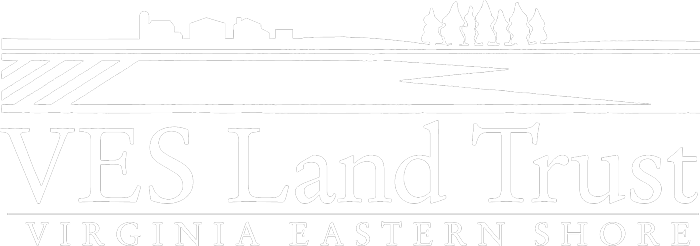All over the Eastern Shore, we are experiencing both sea level rise and sinking land levels. These trends put our waterfront lands at risk. When the slope to sea level is gradual, there is space for marshes to expand and migrate landward. However, land with higher elevations and structure and infrastructure in the way is less resilient. Often a cliff forms and each storm or high tide event takes more soil away. While this sand and soil migration is a natural process, left unmanaged the speed and damage of erosion can be catastrophic. Managing this change is not simple and must be done with care for fragile ecosystems.
A number of landowners with VES Land Trust easements are deeply concerned about erosion and its progression along their protected shorelines. To help, VES Land Trust organized a visit by the Shoreline Erosion Advisory Service (SEAS) staff, a service for landowners provided by the Commonwealth of Virginia within the Department of Conservation and Recreation. SEAS staff visited properties with VES Land Trust to explore options for managing erosion. In addition, the SEAS engineering staff are excellent resources to understand available state and federal programs to partially fund a project, such as the Virginia Conservation Assistance Program (VCAP). Some programs will cover as much as 75% of the total project costs.
The key to building a successful erosion plan is to carefully account for local and site specific conditions. One of the important variables is the fetch or horizontal distance over which wave generating winds can blow. The more open water available from a given wind direction, the greater wave energy against the shoreline.
Creating structures can absorb the energy. In nature, this process is often accomplished in lower energy environments by vegetation that slows the progression of a wave, reducing its energy as it passes through marsh grasses or other salt tolerant vegetation. In high energy situations, dunes allow the waves to roll up the dune releasing their energy and actually depositing sand to build the dune without damaging the shoreline.
Traditional structures fall short
Traditional man-made control techniques for erosion usually focus on hardening shorelines. A classic approach is to build a bulkhead of hard materials or to use rip rap, large piles of rock. Both of these approaches have significant tradeoffs. They can be expensive. The heavy equipment that moves the rocks into place on remote shoreline areas is damaging. Storm events, ice in the winter, and corrosion of time destroy the structure. Structures need to cover all of the eroding surface or they can be compromised by erosion accelerating at the ends. Since shoreline erosion does not follow property lines, coordinated efforts are sometimes required by multiple landowners at once. Finally adding structure can cover up marsh grasses and beachfronts. The wave energy hitting against the structure can scour out the shoreline, undermining the natural structures that provide shoreline habitat and resilience.
Living shorelines protect people, land, wildlife, and water quality
As the SEAS representatives explained, the preferred method in lower energy situations is a living shoreline, which expands the vegetative area that absorbs wave energy. The most common approach is to place some sill material in the water and back-fill with sand to the marsh line. Shorelines may need to be re-graded. New plantings of native marsh grasses are planted into the sand fill between old shoreline and the sill.
In effect, living shorelines create a larger marsh boundary, eventually move the high tide line further out, and allow storm events to dissipate energy by waves rolling through vegetation on a gradual slope. More marsh grass and vegetative buffer means more wave energy absorbed and a more naturally resilient and productive shoreline. Living shorelines protect your land and provide important habitat. The marsh edge is a critical nursery area for most of the aquatic life we cherish on the Shore.
Commonly sills were made from rock sized according to the wave energy conditions. But rock sills on the Eastern Shore are expensive because of transport costs. The Nature Conservancy has been experimenting making sills made from oyster castles. These interlock, are smaller, more transportable, and can be placed without the damage of using heavy equipment. Oyster filled bags are another option to create the sill. Oyster castles or bags of oyster shells can be rapidly colonized by shoreline animals such as other oysters. This locks the sill together and provides additional resiliency to absorb wave energy. A living sill cover of oysters also makes the sill more adaptive to sea level changes since oysters can continue to grow upward as the water rises.
How to get started
Before any work is planned on your shoreline, a detailed plan with drawings is required. If you have a VES Land Trust held conservation easement, consult with staff. The base permit required is called the Joint Permit Application (JPA). It covers the local Wetlands Board, Virginia Marine Resources Commission (VMRC), The Army Corp of Engineers, and Department of Environment Quality (DEQ). The SEAS service is available to help coach landowners with project advice and plan evaluation.
If you are interested in learning more about SEAS and their work, visit https://www.dcr.virginia.gov/soil-and-water/seas. The JPA permits are available online by searching “Army Corp of Engineers Norfolk JPA.” Accomac and Northampton counties both have environmental staff members. Contact Chris Guvernator in Accomack and Katie Spady in Northampton to get started.
It is best to start with either SEAS, environmental consultants, or your local county environmental resource. If a more natural option such as a living shoreline is appropriate, the benefits to water quality and the ecosystem are compelling arguments.

